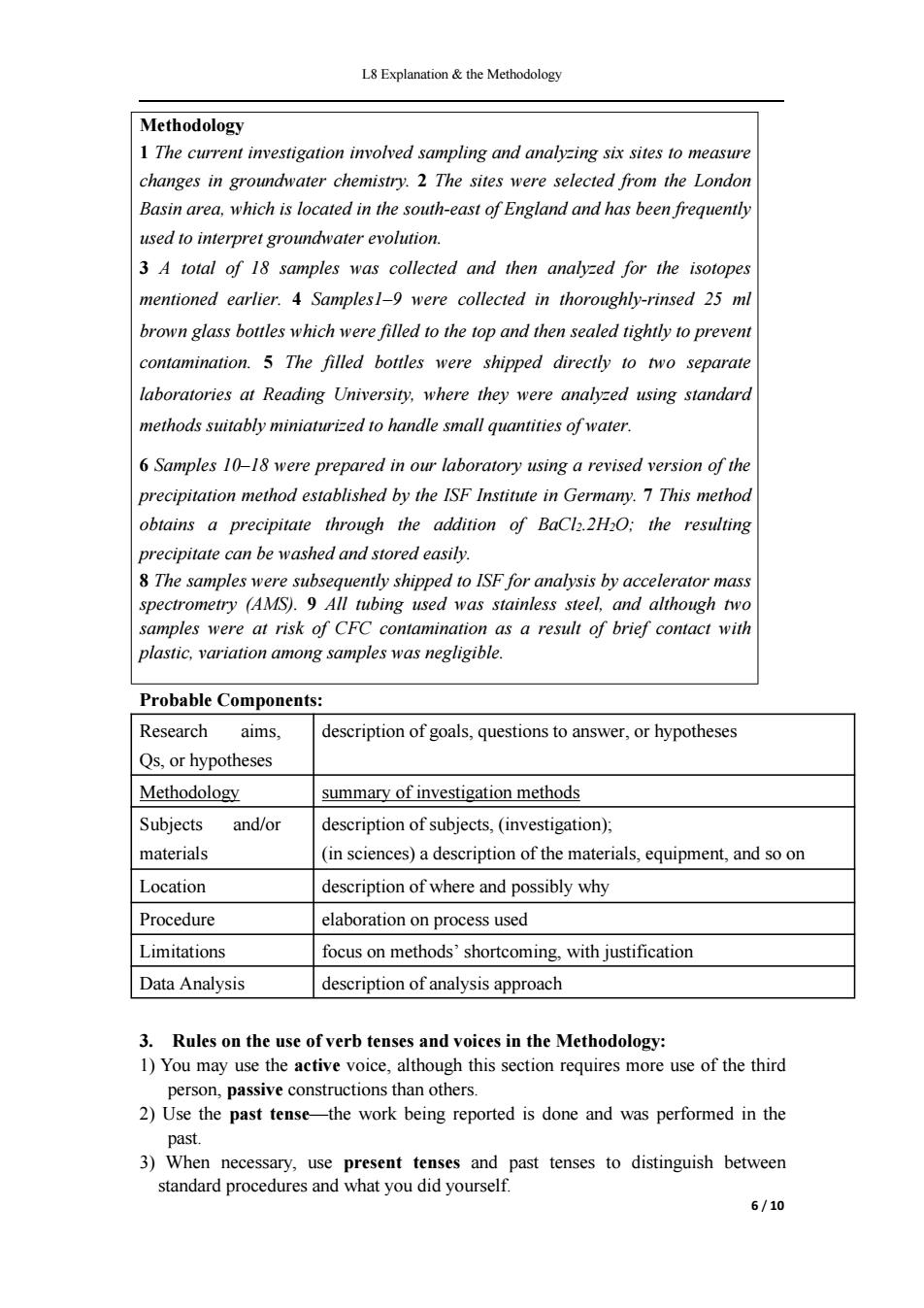正在加载图片...

L8 Explanation&the Methodology Methodology 1 The current investigation involved sampling and analyzing six sites to measure changes in groundwater chemistry.2 The sites were selected from the London Basin area,which is located in the south-east of England and has been frequently used to interpret groundwater evolution. 3 A total of 18 samples was collected and then analyzed for the isotopes mentioned earlier.4 Samples1-9 were collected in thoroughly-rinsed 25 ml brown glass bottles which were filled to the top and then sealed tightly to prevent contamination.5 The filled bottles were shipped directly to two separate laboratories at Reading University,where they were analyzed using standard methods suitably miniaturized to handle small quantities of water. 6 Samples 10-18 were prepared in our laboratory using a revised version of the precipitation method established by the ISF Institute in Germany.7 This method obtains a precipitate through the addition of BaCl2.2H2O:the resulting precipitate can be washed and stored easily. 8 The samples were subsequently shipped to ISF for analysis by accelerator mass spectrometry (AMS).9 All tubing used was stainless steel,and although two samples were at risk of CFC contamination as a result of brief contact with plastic,variation among samples was negligible. Probable Components: Research aims. description of goals,questions to answer,or hypotheses Qs,or hypotheses Methodology summary of investigation methods Subjects and/or description of subjects,(investigation); materials (in sciences)a description of the materials,equipment,and so on Location description of where and possibly why Procedure elaboration on process used Limitations focus on methods'shortcoming,with justification Data Analysis description of analysis approach 3.Rules on the use of verb tenses and voices in the Methodology: 1)You may use the active voice,although this section requires more use of the third person,passive constructions than others. 2)Use the past tense-the work being reported is done and was performed in the past. 3)When necessary,use present tenses and past tenses to distinguish between standard procedures and what you did yourself. 6/10L8 Explanation & the Methodology 6 / 10 Methodology 1 The current investigation involved sampling and analyzing six sites to measure changes in groundwater chemistry. 2 The sites were selected from the London Basin area, which is located in the south-east of England and has been frequently used to interpret groundwater evolution. 3 A total of 18 samples was collected and then analyzed for the isotopes mentioned earlier. 4 Samples1–9 were collected in thoroughly-rinsed 25 ml brown glass bottles which were filled to the top and then sealed tightly to prevent contamination. 5 The filled bottles were shipped directly to two separate laboratories at Reading University, where they were analyzed using standard methods suitably miniaturized to handle small quantities of water. 6 Samples 10–18 were prepared in our laboratory using a revised version of the precipitation method established by the ISF Institute in Germany. 7 This method obtains a precipitate through the addition of BaCl2.2H2O; the resulting precipitate can be washed and stored easily. 8 The samples were subsequently shipped to ISF for analysis by accelerator mass spectrometry (AMS). 9 All tubing used was stainless steel, and although two samples were at risk of CFC contamination as a result of brief contact with plastic, variation among samples was negligible. Probable Components: Research aims, Qs, or hypotheses description of goals, questions to answer, or hypotheses Methodology summary of investigation methods Subjects and/or materials description of subjects, (investigation); (in sciences) a description of the materials, equipment, and so on Location description of where and possibly why Procedure elaboration on process used Limitations focus on methods’ shortcoming, with justification Data Analysis description of analysis approach 3. Rules on the use of verb tenses and voices in the Methodology: 1) You may use the active voice, although this section requires more use of the third person, passive constructions than others. 2) Use the past tense—the work being reported is done and was performed in the past. 3) When necessary, use present tenses and past tenses to distinguish between standard procedures and what you did yourself